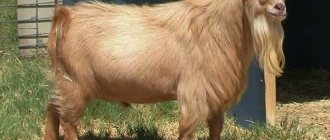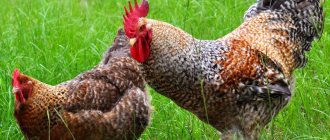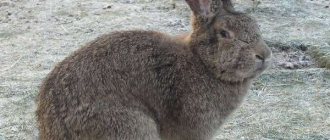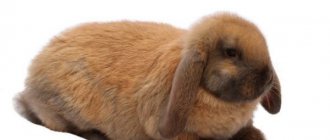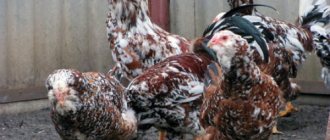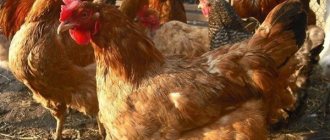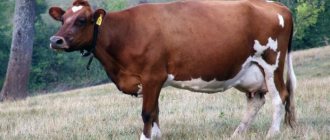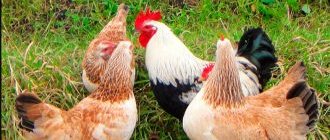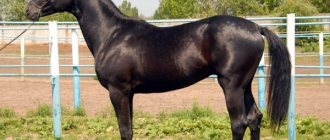Goats are one of the very first animals domesticated by humans. They have been and will be a source of important products - meat and milk, as well as wool and fluff. There are many breeds of domestic goats, of which one of the oldest is the Nubian. When did this valuable breed appear, why is it interesting, what are its main advantages, let’s try to figure it out together.
History of the breed
When talking about the Nubian goat breed, you need to know that we are usually talking about a selectively bred Anglo-Nubian breed. Wild mountain goats, also called Nubians, are only partially related to the breed.
Nubian goats are perhaps one of the most successful human acquisitions in animal husbandry. In Europe, these animals are found very often. In Russia, the breed became popular relatively recently. But their breeding is gaining momentum year by year. Their history goes back to the distant past.
During scientific research, it was found that similar goats were near people more than 9 thousand years ago. The name comes from the birthplace of the animal, taken as a breeding basis - the Nubian Desert in eastern Africa, Sudan. In ancient times, this territory was in the possession of Egypt.
It was there that the first Nubian goats were bred by ancient Egyptian livestock breeders. It was only in the Middle Ages that French researchers left the first records about this breed. Modern history began as a result of breeding work carried out by British livestock farmers starting in the 19th century.
At the origins of the selection there were 2 pairs of goats - one from India, the second - African. The Indian couple was fundamental; it was their remarkable qualities that had the greatest influence on the breed. Subsequently, not only samples from Africa, but also from Europe and Asia were taken as additional specimens.
The result was a wonderful breed of Anglo-Nubian goats, with an unusual exterior, high productivity, and extremely unpretentious. The name “Nubian” was officially assigned only at the end of the 19th century, after the first specimens arrived in America. Since 1900, the New World has actively developed its own population, which has become very popular among local farmers.
Goats came to Russia exactly a century later. An invaluable contribution to the selection was made by N.N. Markelova, project manager and director of the Ladushka ANO. It was with her help that samples were delivered, and she also gave rise to the production of unusual animals in Russian open spaces.
Characteristics and description of the breed
Nubian goats were bred in Africa. Their fame and popularity began in the 19th century, when the British learned about their productive qualities. Later in England they began to improve and adapt Nubian goats to European conditions. Nowadays, Nubians usually refer to the Anglo-Nubian goat breed and similar crosses.
The Anglo-Nubian goat is a large dairy breed known for its high-quality, tasty milk without the characteristic goat smell. The high fat and protein content is highly valued by cheese producers. The Anglo-Nubian goat was developed in the 19th century in the British Isles by cross-breeding breeds of English, Middle Eastern and North African origin. Anglo-Nubian goats are characterized by heads with a Roman profile and wide, drooping, long ears. The main thing is that they comply with the breed standard, i.e. had a Roman nose and long, bell-shaped, drooping ears.
The breed is characterized by a large body with a solid constitution, high legs, a typical beak-shaped head and wide drooping ears. Horn is not a typical characteristic. The back is straight and long, at the sacrum it may be slightly higher than at the withers. The udder is round with a wide base. Division into shares is not expressed.
Description of the breed:
- ears - a typical indicator of the Anglo-Nubian goat is long, wide ears hanging down, the length of the ears is 15-25 cm;
- the shape of the head is convex, with a pronounced hump of the nose (Roman profile);
- the head is short;
- the upper lip is shorter than the lower lip and therefore the teeth are exposed;
- eyes are large;
- cheekbones are pronounced;
- the coat is short and fine;
- color black, dark brown or reddish brown with or without white markings;
- The breed has long legs
- horns - most animals are dehorned, there are few polled animals, males may have large horns, set to the side and slightly curled, while queens have small, saber-shaped horns;
- catkins – the English standard excludes animals with catkins, other countries may have exceptions;
- beard - not regulated, but usually Nubian goats do not have a beard, and the goat has a small one;
The color can be any: plain or a combination of several colors (spotted like Dalmatians and striped like zebras). Their coat is soft and silky compared to other breeds. Nubians are a large breed: females reach 76 cm or more in height, males - 81 cm or more.
It should be understood that Nubian goats have two specific traits. They are very stubborn and capricious and love to shout. The vocal abilities of these goats can drive even the most patient goat breeder crazy, and they will bring so much joy to your neighbors. So this is an ideal breed if your neighbors have geese - now let them get used to the animal calls!
Exterior assessment and standard - video
Productivity indicators of Nubian goats
To date, a record annual milk yield of 2531 kg has been officially registered among Nubians in England, and the maximum daily milk yield recorded at the BGS show is 8.25 kilograms (in 24 hours).
The breed is characterized by a high fat and protein content in its milk. In the US, the average fat content is 4.5-5%. The animals belong to the meat and dairy type, so milk yield indicators are inferior to specialized breeds. The best representatives show results of 750-1000 kg of milk during lactation. But the average milk yield is as follows:
- milk yield for 305 days of lactation - 608.7±83.64 kg;
- milk fat content - 4.30 ±0.03%
- milk fat for 305 days of lactation - 26.96 ± 3.79 kg;
- protein content – 3.61%;
- daily milk yield – 1.84 ± 0.20 kg;
- lactose – 4.5%;
- vitamin A – 0.014 mg/100g;
- vitamin C – 1.7 mg/100g;
- essential amino acids – 125.3 mg/kg;
- density – 1028 kg/m3;
- acidity – 19-20.
Domestic studies show a high consumption of milk from Nubian goats for the production of cottage cheese (5.2 kg of milk per 1 kg of cottage cheese) - in this indicator they are inferior to Saanen, Alpine and a number of other dairy breeds. But in terms of fat and protein content in the finished cheese, Nubiki are superior to these same breeds.
But the highest cheeseability of Nubian milk is of greatest importance. To produce 1 kg of feta cheese, 4-4.4 kg of milk is required, which is almost 500 grams less than from goats of other breeds. In addition, the resulting cheese contains more fat and protein. Taking into account the fact that Nubian goats are not much inferior in milk productivity (milk yield for 305 days of lactation), breeding this breed for the purpose of cheese production is very promising.
The high level of fat and protein in milk, good cheese yield, and strong constitution increase the potential for use of the Nubian breed. In addition to purebred breeding, Anglo-Nubian goats are actively used in improving crossbreeding. In most cases, purebred goats are purchased and covered with local goats. But work is also actively underway on crossing with Saanen and other dairy breeds. This is necessary in order to increase the fat content of the milk (Saanen milk is low-fat and is not suitable for making cheese - it costs a lot).
In addition, improving crossbreeding allows for serious savings - one goat costs significantly less than a batch of goats. Therefore, in Russia, as well as in many other countries, purebred breeding of Nubian goats is not represented. Moreover, there is a danger of acquiring various kinds of crossbreeds under the guise of purebred animals - some goat breeders are not honest.
Hybrid of Nubian and Saanen breeds
Video about milk and productivity of the Nubian breed
Description and features
The Nubian breed cannot be confused with another. The main difference between Nubians is their long drooping ears and slightly humped nose, giving a “Gascon” nobility to their profile. Sometimes it is called the “Roman profile”. The animal's eyes are large, velvety and resemble the eyes of a deer.
Above them are heavy brow ridges, and above them is a massive and steep forehead. The typical Anglo-Nubian goat is larger in size and carries more meat than other breeds. It is powerful, an adult can weigh 60-70, some reach up to 100 kg, but it looks graceful.
The body is elongated and not very wide, but large, the height at shoulder level is 80-90 cm. The long legs are slender and quite straight. Males have small horns curved backwards. Females are usually without horns (polled), from which they are removed at the age of 2 weeks. Goats have large udders and long nipples.
They are inferior in weight and size to males. Adult goats weigh 45-55 kg. The coat is smooth and delicate to the touch, short and thin in appearance, without undercoat. The color of goats and goats can be very diverse - from coal-black or snow-white to velvety fawn or intricately spotted.
Animals have a loud voice, but they do not like to attract attention to themselves unnecessarily. A demanding bleat can only be heard if something is truly bothering them. Maybe from cold, hunger, fear or loneliness. And their bleating greeting sounds different, not at all demanding.
In a herd they behave friendly, perceive their owner as a leader, and can even play with him. The Nubian goat in the photo from the side looks a little arrogant due to its outstanding profile, and from the front it looks very kind and affectionate due to its large ears and expressive eyes.
Appearance of Nubians: amazing color and breeding qualities
The Nubian goat is strikingly different from the usual “aboriginals” of our country. It cannot be confused with any other breed. Just look at the long drooping ears. This also includes the nobility of the “Roman” profile, the humped nose. Goats' eyes resemble deer. Their brow ridges are heavy, their forehead is massive and steep.
Adult
Nubian goats can be anything in color - from jet black to intricately spotted. Variegated specimens look especially beautiful. There are brown individuals with a black stripe along the ridge, reminiscent of Przewalski's horses.
The breed is classified as meat and dairy. The animals are distinguished by a very large body, a long narrow body, powerful legs, a thin neck, and in females an impressive udder with long nipples. Goats can be polled, male goats must have a beard and strong, short horns. The height at the withers often reaches 90 cm and above. Goats weigh about 70-80 kg, bucks - about 130 kg.
Male and female Nubian breed
Kinds
Speaking about the varieties of Nubian goats, one cannot fail to mention one of the wild ancestors of these creatures. This is a Nubian ibex . The mammal weighs 62.5 kg, the body is 125 cm long, and the height at the withers is 75 cm. Females are usually smaller than males. They weigh only 26.5 kg, length 105 cm, and height 65 cm.
The fur is reddish-brown with rare black and light spots on the limbs, the abdomen is entirely white. They have prominent horns, in both sexual varieties. Only in males do they grow a meter long, bending first towards the back, back, then down. Goats have horns that are only 30 cm long.
The Nubian ibex lives in mountain gorges, rocky areas and rocky deserts. Two populations are currently known. One, Capra nubiana nubiana, is considered the nominative species. She chose northern Africa and the Arabian Peninsula to live in, and lives up to 2800 m above sea level.
The second - Capra nubiana sinaitica (Sinai mountain goat) - considers the mountainous desert regions of the Sinai and western part of the Arabian Peninsula, as well as the sands of the Negev Desert, comfortable for itself.
If we return to the Anglo-Nubian breed, then at the moment we can talk about 3 varieties - English, Australian and American. At first glance they are similar, but still these species are different.
- “English goats” are larger than others, they have more varied colors, and their goats have larger udders. Many years of selection experience take their toll.
- Australian breeders spend a lot of effort on maintaining the appearance of their pets. Therefore, their animals belong to the category of “the very best”: they have the longest ears, the most hooked noses, the longest legs. In addition, “Australian women” most often have a protruding lower jaw, and hence an incorrect bite. They don't consider this a fault of the breed.
- “American women” can be proud of the most correct udder shape. They are slightly smaller than their overseas relatives and do not have such a wide variety of coat colors. In addition, their ears are slightly shorter, but their nose is more humpbacked.
To summarize, we can say that all these varieties, despite some external differences, have a similar disposition, as well as approximately the same indicators of productivity and quality of milk.
Popular breeds
The Saanean race is a goat native to Switzerland. The name comes from the name of one of the largest rivers flowing through Switzerland (in German - Saane, in French - Sarine). Saane goats and their varieties can now be found throughout the world. These purebred animals greatly influenced many local goat breeds, primarily those with white coats. In France, this species is one of the most common.
Saane goats are usually medium in size. They have a white or light cream colored coat that is quite short. Milk yield is over 1400 liters per year.
The Toggenburger Ziege goat is one of the oldest dairy breeds. They come from the Toggenburg region of Switzerland. Representatives of this breed were exported to many countries around the world.
Females reach a body weight of 55–80 kg, and males – 70–110 kg. They have erect ears. Males have a beard. The coat is soft, short or medium length. Skin colors range from light brown to dark chocolate. Milk production reaches 1000-2000 l/year. They are well adapted to cold climates.
German White Noble (Weiße Deutsche Edelziege) goats were developed in Germany by crossing local breeds with Saanean goats imported from Switzerland. At the end of the 20s of the twentieth century, such breeding animals were considered a new breed, which is why the above name was proposed. German white goats are mainly kept in western Germany (Baden-Württemberg, Lower Saxony, North Rhine-Westphalia and Schleswig-Holstein).
This breed has a white short-haired coat. An individual produces from 900 to 1200 liters of milk per year with a fat content of 3.2 to 3.6%.
Representatives of the Anglo-Nubian breed were obtained in England in the 19th century by mixing Nubian Egyptian, Indian and indigenous British animals. Anglo-Nubian goats are bred all over the world. But most of them are in Europe, North, Central and South America, and Kazakhstan. In many developing countries they are used to improve local breeds.
These animals reach large sizes. Females are about 75 cm tall at the withers and weigh up to 110 kg. Their coat is short, its color can be white, brown, brown, black. They are characterized by low milk yield (usually below 1000-1250 l), with high fat and protein content in milk (approximately 5.0% and 3.6%, respectively).
Murciano-Granadina is a breed of goat from the southeastern regions of Spain. Its name comes from the city of Murcia, which is the capital of the autonomous region of the same name, and Granada, located in the neighboring autonomous region of Andaluja. These goats are perfectly adapted to dry and hot climates.
The coat of females is short and delicate, while that of males is longer and thicker. Animals have a uniform color of various shades from brown to black. The milk yield of animals of this breed is about 500 liters (the fat content in it is about 5.3% and the protein content is about 3.5%).
The Damascus breed was developed in Lebanon and Syria, and its name comes from the capital of Syria, Damascus.
These individuals are medium to large in size. Females reach 65-70 cm at the withers and weigh about 40-65 kg, and males - 80 cm and 50-90 kg, respectively. Animals have different colors. Most often they are red or brown. Milk yield - from 260 to 700 liters (fat content - 3.8-4.5%, protein - 4.0-4.8%).
The Carpathian breed is a species that appeared in the 19th century. Indigenous Carpathian goats are medium-sized animals. Females at the withers are about 60 cm tall and weigh 30–35 kg, while bucks are about 70 cm and about 50 kg, respectively. The animals are covered with semi-long hair (goats - up to 21 cm and goats - 31 cm) of white color. Milk yield is about 450 liters (milk protein – 2.8%, fat – 3.4%). Fertility is about 100%.
Alpine goats are animals with a strong physique. They have a brown coat with shades ranging from light to chocolate. The breed is characterized by high milk production, fertility and harmonious structure. The body weight of an adult of either sex is about 90 kg.
The Boer breed is characterized by a compact stocky body, short strong and muscular limbs, and a developed croup. These goats have slightly drooping ears. Animals with horns, short white and shiny hair. The head and neck are red with a white arrow. There may be red spots on the trunk and limbs.
Reproduction efficiency – 140%. The weight of the individual is 75-120 kg.
Lifestyle and habitat
Nubian goat breed , as already mentioned, is widespread in England, Scotland, America, Australia, as well as in Sudan, Ethiopia and many European countries. In our country, they are usually bred closer to the south, as well as in some central regions - Moscow, Tver and Samara.
Recently, breeding has become increasingly common beyond the Urals, in Siberia. When determining a place for grazing, you need to take into account its height relative to other landscapes. Nubians love dry and tough steppe vegetation more than wet lowland grasses. But there must be a pond next to the pasture.
It is advisable to bypass industrial facilities at least 5 km. Their desire to frolic or climb higher on a hill can be taken into account in hilly areas. The pasture area is divided into several zones, releasing the herd into each of them in turn. This will help you use natural feed continuously.
The general principle of keeping such goats in Russia is pasture-stall in half. They can be on pasture for six months, in a stall for six months. When grazing, goats must be tied. However, with a large population, you can limit yourself to simply supervision.
Origin of the Nubian breed, advantages and appearance
Goats with long drooping ears and rich coat color are more characteristic of the African continent; it was from there that the first representatives of the Nubian breed were brought. The ancestors of modern goats of this breed grazed in the endless steppes of South Africa, and specifically in Namibia, which at that time completely belonged to the English crown. Only at the very beginning of the twentieth century, several females and males were brought to Great Britain, where local breeding masters began to work on them.
Important
The basis for the crossing was the real Nubian goat, as well as the Old English breed, which was bred here in the third millennium BC. However, these are not all representatives of the goat kingdom that took part in the crossing to breed a pure Nubian breed. Breeders also tried on other breeds that were previously imported from Russia, Egypt, India, the Middle East and other regions.
When the breed was bred, its original exterior, that is, its appearance, remained virtually unchanged. What remains are the hanging ears and the bright, black-brown color of the fur, sometimes covered with spots. But productivity indicators in terms of obtaining the maximum amount of milk from one queen have increased noticeably. Despite the fact that the breed is called Nubian, it should be understood that not a single representative of it has ever, in fact, been to Africa, so there is no need to fear that the animals need an exceptionally hot and arid climate.
It was only in 1896 that the breed received official recognition and the name Nubian. A few years later, the males were brought to the United States, where the population began to grow exponentially. True, this meat and dairy breed cannot be called the most popular in the world, since professional farmers often prefer the good old “classics”, such as Saanen and Alpine Swiss goats. Nubian goats came to Russia quite recently, in the second half of the tenth years of the new century. They are preferred by exotic lovers, so there is no need to talk about the discovery of breeding reproducers and mass breeding yet.
Advantages of the breed
In appearance, all Nubian goats, a photo can fully confirm this fact, without competition. They are original, unlike other representatives of the species, but they also have other advantages.
- Many breeders of Nubian goats note that their productivity, however, from the second or third lactation, can easily reach five liters of milk per day.
- The milk of such goats has a high fat content, which is why it is even preferred by professional cheese makers, for example, in Switzerland.
- Young animals gain weight extremely quickly, and their meat is considered a delicacy in many countries.
- The lactation, that is, milking, period of the Nubian breed is at least three hundred days a year.
Nubian females can give birth not once, but twice a year, and two or three kids are usually born in one offspring. In addition, they are born quite large, strong and hardy, and rarely die small.
Nutrition
There is an opinion that Anglo-Nubians are demanding when it comes to food supply, but in reality they are quite unpretentious animals. They enjoy eating grain and dry grass. In the pasture they feast on fresh grass or young shoots. You just need to carefully monitor their diet, they are prone to overeating.
The general diet, like that of other goats, consists of crushed grain, hay, bran, cake, branches and grass and vegetable waste. You can also additionally give them special food in the form of muesli. Usually these are balanced mixtures, consisting of a set, the composition of which changes with the age of the animal. The coarseness of grinding of such feed also varies, depending on the intended purpose - for breeding goats, kids, milking or cloth (covered) goats.
For example, to improve milk yield and quality of milk, you can use a mixture of micronized flakes (obtained as a result of processing grains with infrared rays, which gives a crumbly structure) of grain crops - oats, barley, wheat, corn, as well as beet cake, molasses, flaxseed and sunflower meal , dried carrots, beets.
When planning your menu, don't forget to occasionally add chalk for calcium. Regardless of age, they should have enough water. And also sometimes put in special licking blocks based on table salt.
This helps them replenish sodium and chlorine deficiency. Just do not overuse them to avoid dehydration or poisoning. For the winter, you can stock up on the maximum number of brooms made from linden, willow or hazel. Just not birch trees.
Where to buy purebred goats/Nurseries and price
It will not be easy to buy kids, females, or especially breeding male goats in our country. There are no large nurseries that breed this particular breed in Russia yet, so you will have to rely only on small farms or bring animals from abroad.
- In a private farm in the city of Anapa, in the Krasnodar Territory, breeder Elena Yuryevna Yakovenko offers goats and male goats of the LaMancha breed.
- The private farm “Teply Dvor”, located in the town of Borovsk, Kaluga region, offers goats and female goats of the same breed aged from five months. All animals have documentation, the coloring is similar to Alpine goats, the wool is thick, suitable for growing in cold conditions.
- In the Northern region of Veliky Novgorod, the private breeding farm "Europe VN" offers imported kids and adults of the LaMancha breed from the United States.
- In Novosibirsk, not far from the Lenin Square metro station, breeder Maria Averkova offers kids from high-yielding goats, including La Mancha.
The cost of a purebred animal can be quite high, although it cannot be compared with the Saanen or even Nubian breed. A breeding goat will cost only 20-25 thousand, and a female goat is even cheaper, up to about fifteen thousand rubles. Kids are sold for 5-8 thousand, depending on age, weight, personal parameters and other things.
Reviews about goats
Nadezhda Sorokina, 48 years old, Stary Oskol:
“Not so long ago, the children gave my husband and I a goat with a kid, and we immediately became friends with them. Before this, there had never been goats on the farm, but La Manchas turned out to be unpretentious, they eat everything, they love tree branches and shrubs. I would like to note that there is absolutely no smell either from the goats themselves or from their milk. I specifically went to “sniff” the neighbor’s simpletons, but it turned out I hadn’t lost my sense of smell. I think it would be a good idea to breed such animals, since I get about 2-3 liters of milk per milk yield when milking twice a day.”
Olga Kalyuzhnaya, 54 years old, Razdolye village:
“We bought the LaMancha goat quite recently, now she is only nine months old, so I can’t say anything about milk and offspring yet. After the purchase, the whole village came to see my unusual pet, she was so good. Her ears are small, like shells, and her son thinks she looks like a llama. The goat's character is very affectionate, she rubs against her legs, loves to have her side, neck or back scratched, puts her head on her knees and touchingly looks into her eyes when she wants something “yummy.” I’m going to buy a few more LaManchas for breeding.”
Reproduction and lifespan
Usually young animals are acquired first. Here it is important to show maximum responsibility in your choice. Compliance of the parameters with the standard must be documented. You can ask to taste the milk of the mother goat. Kids need to be purchased from different litters, and preferably from different farms.
With close kinship, the offspring will be unproductive and weak. You can breed goats of this breed starting from 8 months of age, but it is better to go beyond the one-year mark. The process is planned for the end of summer so that the kids will be produced by the end of winter.
It is believed that this breed is not fertile. However, each goat can exhibit sexual instinct once every 17-20 days. This becomes noticeable in the goat’s restless behavior and poor appetite; in addition, it is constantly capricious, bleating and butting.
Pregnancy lasts 150 days. As a result of lambing, 2-3 kids are obtained. The kids are large and can be kept separately from the goat within a couple of days after birth. It is important that in the first days they receive maternal colostrum, this will help the formation of immunity, which they do not have at birth.
Reproduction
Nubians are very fertile - under good conditions, goats can lamb twice a year, with 2-3 babies in a litter. It is this fertility that makes raising Nubian goats for meat so attractive. The duration of pregnancy is 150 days.
Goat breeds: breeding, maintenance and care of the most common breeds. Distinctive features and tips for choosing a goat (100 photos and videos)
Goat skin: dressing, quality assessment, features and care rules (video + 105 photos)
Alpine goats - description, characteristics, breeding and maintenance. Advantages and features of the breed (80 photos)
Goats are sexually mature at 7-8 months, but you should wait up to a year with your first pregnancy.
Household care and maintenance
People keep Nubian goats on their farms quite often. Their breeding is relatively simple, and the animals themselves are not whimsical. They like both meadow grazing and grass on their plot. Prerequisites are warm housing and proper feeding. The barn for them must be heated, dry and light.
They do not tolerate drafts, so it is necessary to seal all the cracks and holes in the walls. But some ventilation is still necessary to prevent the bedding from overheating, so it’s better to do it yourself. In addition to a window, or better yet several windows, you need to bring light into the room. This will brighten up the short winter days for them.
The bedding is made from a layer of hay, sawdust or straw. The thickness is expected to be from 40 to 50 cm. It provides thermal insulation and protects against cold weather. Goats do not like to sleep on the floor, so it is advisable to build beds for them. To do this, a platform is made of wide boards around the perimeter of the room at a height of 40 cm from the floor.
In addition, their “mountain past” haunts them; they love to climb everywhere. Therefore, you can make them a few more hills. It is better to keep them with relatives. Although sometimes they can be placed with other goats and even birds.
Walking is an important part of keeping Nubian capricious cats. Therefore, they often make a pen next to the barn. In any weather, except severe frost and wind, they must have access to fresh air.
Goat kids are usually kept separately from adult animals; their premises are equipped almost the same, only the flooring is lower. Sometimes goat houses are additionally insulated for the winter with pine branches, and the windows are sealed from the inside.
Features of the breed
Despite the process of acclimatization of Nubian goats carried out by English breeders, they still do not tolerate the harsh Russian weather conditions very well in many regions. Air temperatures below -18 degrees Celsius can be fatal for them and the animals will die. Therefore, not every compatriot will be able to raise these animals. Most often, breeders of these breeds live in the southern regions of Russia, as well as in the Tver, Samara and Moscow regions.
Important
Please note that Nubian goats in most cases will not tolerate other animals or even other breeds of goats around them. They become aggressive, which often affects their owners, who cannot understand why this affectionate goat began to butt while milking or feeding.
Nubian goats react negatively to high levels of dampness and low temperatures. When kept in such conditions, adult goats can develop pneumonia (pneumonia), and goat kids will die immediately after birth. Therefore, the optimal place for year-round maintenance will be a warm and dry barn, with seasonal pasture. That is, several conditions can be set for the holding room: warmth, light, dryness and good ventilation without drafts.
Each individual should have its own bed, which is covered with fresh straw. The litter should be changed regularly, once a week maximum, so that the Nubian can choose and eat the most appetizing stems. Such an animal will not sleep on dirty or old bedding and will become restless, which always negatively affects milk yield.
How and what to feed this breed
Keeping Nubian goats is somewhat more difficult than normal ones, even in terms of style and nutritional principles. The diet of these exotic animals must be strictly and unconditionally observed. It is necessary to pay attention to the feeding regimen, which is also very important. In winter, feed should be provided exactly three times a day, preferably at the same time, to avoid stress, which will inevitably affect milk yield. Let's figure out what is included in the winter diet.
- Fresh hay - from two to five kilograms per day.
- Grain-type concentrates – up to two kilograms.
- Silage, chopped shoots of trees or shrubs, vegetables - up to one kilogram.
The amount of concentrate for each individual can be calculated more accurately; it is not difficult. Three hundred grams is a mandatory amount, to which you need to add another 250 grams for each liter of milk yield. It also doesn’t hurt to make “brooms” that can be hung in the stall as a “snack.” They are mainly made from green-barked pine, linden, willow, hazel, maple, willow and even prickly acacia.
In order to increase milk yield, Nubian goats are given ground or steamed oats and barley. Experts believe that vitamin supplements are also required for such animals. It is optimal to purchase concentrated feeds with premixes that contain them. In summer, special salt licks are made for goats, and in winter it is better to give warm water with salt diluted in it. You should also constantly add chalk to the feed, which these exotic animals need. Do not forget that during the mating season, goats need increased nutrition, this is important.
Pros and cons of the breed
Positive sides:
- The product has no characteristic odor.
- The milk is of high quality.
- They are quite fertile and have good health.
- They are sociable and active, although these qualities also have a negative side.
- They are affectionate, compliant and submissive towards their owner.
- Their character can be called friendly, cheerful, and they often become family pets. They get along great with children.
- They are smart and beautiful in appearance.
Negative sides:
- They do not tolerate extreme cold well due to the lack of undercoat.
- They require more attention than other goats, so they are more suitable for breeding on small farms.
- They can be stubborn and restless (remember, mobility?), so only an adult should do grazing.
- Sociability sometimes borders on cockiness; they can butt heads even without horns. But they quickly give up if they see their opponent’s superiority.
- High cost of animals.
Features of breeding Nubian goats
Since the breed is young, there is no large breeding base. But in our country they are practically absent. The first attempts to import these goats were made in 1999 and now the situation has not changed at all. There are no breeding farms in our country, and in 99% of cases they sell not purebred Nubians, but unknown crossbreds with drooping ears.
Therefore, purebreds can only be purchased abroad. But you should remember about the breed classification:
- PB (purebred) – 100% purebred animals in the 10th generation;
- AM (American) - at least 3-4 purebred ancestors in the family tree, 3 for goats, 4 for bucks;
- RG (registered grade) - one of the parents is registered as a purebred, while the second ancestor is unknown or has no documents.
But even if you acquire this breed, you will not get rid of difficulties. Anglo-Nubians are very heat-loving animals and do not like our climate. There are experiments on crossing Nubians with wool and downy breeds, but this is a perversion that disfigures the phenotype. Therefore, you definitely need a warm goat house with excellent ventilation - goats are picky about air pollution.
The next problem is the stubbornness of these animals. They are very difficult to care for, so there are great difficulties in automating production and breeding on a large farm. In addition, this goat is very demanding on the quality of feeding - a deficiency leads to a sharp drop in productivity.
Reviews of Nubian meat and milk
Nubian goat meat is an excellent dietary product. Moreover, based on the dimensions, there is quite a lot of meat. It is rich in amino acids, fats and vitamins. Indicated for elderly people, children, patients with heart and immune deficiency.
Milk has high fat content, approximately 5-8.5%. And the protein content in it is 3.7%. It is superior in quality and fat content to the milk of many other domestic animals. One Nubian female can produce 3.5-5 liters of milk per day. It makes excellent cheese, cottage cheese and yogurt.
It should be noted that the taste of milk is very pleasant - creamy, rich and delicate. Some people find it tastes like ice cream, nuts or nutmeg. In terms of microelements content, it is close to human breast milk. Both meat and milk have absolutely no specific odor.
Interestingly, in the West, goats of this breed are purchased for the herd in order to increase the overall quality of the output. On some sites you can find reviews and advice for beginning goat breeders. Many are interested not only in the usefulness of products obtained from Anglo-Nubians, but also in the return on investment of the animals.
After all, the price for them is considered rather high - from 150,000 to 250,000 rubles for an adult goat, and 100,000 for a month-old kid. In addition, a lot of effort still needs to be put in so that the goat grows and the goat begins to bear fruit. Most often, at least 4 individuals are required for breeding. And these are serious costs. But experienced owners say that with some success, the costs can be recouped in 3-4 years.
Productive indicators
The Nubian breed is considered universal because... gives good results for both milk and meat. The latter direction is less popular in our country, so the emphasis is on dairy products. Goats produce milk approximately 300 days a year. Lactation begins after the first lambing and with each subsequent lamb the amount of milk increases.
On average, female Nubian goats produce 3-3.5 liters of milk per day. About a ton of useful product comes out per year.
The fat content of milk is on average 4.5%, but some individuals produce 8% fat content. It has a fairly high percentage of protein - 3.7%, the milk does not have a goat smell, which many consumers do not like, and the taste is nutty and creamy. The product is suitable for making delicious cheeses, yoghurts, and cottage cheese. According to reviews from breeders, children drink milk from Nubian goats with pleasure.
When animals do not produce enough milk, they are fattened for meat. Nubians quickly gain weight, and their meat is also devoid of a specific smell, it is juicy and tasty regardless of the method of slaughter, and has great nutritional value. This is an excellent dietary product, also suitable for shish kebab and barbecue.
The yield of meat products from goats is quite high: from one individual you can get 50-70 kg of meat (from females and males, respectively). Mostly young animals are slaughtered, as the flesh of adult goats becomes tough.
Experts will tell you more about the exterior and behavior of Nubian goats. Watch the video:
Prospects for breeding goats of the Anglo-Nubian breed in Russia
Goat breeding in general in Russia is very poorly developed, and breeding of Nubian goats is completely concentrated in the hands of very few enthusiasts. The reasons for the low popularity of this breed directly stem from its shortcomings. These goats require too much work to get the same results that less finicky breeds provide.
From the above, only one conclusion can be drawn. In the foreseeable future, the growth in the number of Nubian goats in Russia will be extremely slow. While the Saanen and other equally productive breeds exist, from a commercial point of view there is simply no point in breeding Anglo-Nubians. At the moment, these goats are bred almost exclusively by fans, so to speak. For these people, certain subjective factors (the same beautiful exterior) are of primary importance rather than practical benefits.
xn--80ajgpcpbhkds4a4g.xn--p1ai
Myth 3. Anglo-Nubian goats are restless and loud
Yes and no. Indeed, many goat breeders note that the voice of Anglo-Nubian goats is loud and resonant. And as soon as they arrive at the farm, they begin to shout, give orders, demand!
However, in our experience, they become restless and begin to attract attention by bleating loudly if something really doesn't suit them. Cold, hungry, lonely.
We have created excellent living conditions for our goats. Clean, high-quality food, regular walking, veterinary examination. Therefore, our Anglo-Nubian goats behave well and you can hear their voice, perhaps, as a greeting.
Interesting! The behavior of goats in a herd is very similar to that of dogs. They unconditionally recognize the owner as the leader, showing him friendliness and a playful disposition.
RUSSIAN WHITE GOAT
The White Russian is probably the best representative of our domestic breeds. These goats have well-defined joints, a down-to-earth body, small ears and a beard. The color is predominantly white. This is all the information I learned while visiting the last goat. But for some reason I was sure that “a fisherman sees a fisherman from afar,” so I definitely recognize a Russian, albeit a goat soul, from the mass of others.
There were a lot of goats grazing in the meadow, probably all there were in the village, and each was tied to its own peg. Yes, the task is not as easy as it seemed to me at first... Almost all the goats in this meadow are white, it is not so easy to see the ears from afar. Of course, I was at a distance, you never know what would wander into these marvelous horned heads. But I did see large, clearly defined knee joints in one goat. She probably felt that she was being looked at, and began to bleat continuously, to which a rather young woman sitting on a bench near the outer courtyard reacted vividly. It turned out that this was the owner of the goat that scared me.
The woman introduced herself as Marina, untied the goat, then another, then another, and finally two rather large kids (as big as their mothers). Imagine, but it turns out that I was only able to discern one Russian soul instead of five! We went into the yard, simultaneously discussing all the delights of this breed.
Russian white goats are not very large, weighing from 40 to 50 kg, male goats weigh a little more than 60-70 kg. Goats produce about 3 liters of milk per day with a high fat content of 4.5% -5.5%. Goats are very fertile, they can give birth to kids twice a year, and 3-4 kids at a time. The skin of goats of this breed is very valuable; it is used to produce chevro.
Mating - features of LaMancha
The main and main advantage of the breed is its enviable multiple births. It is extremely rare that there is only one kid in a litter, most often there are two or three, but sometimes there are four, this is quite normal. However, for mating it is better to choose individuals from different litters, since closely related breeding can cause a sharp decrease in already not outstanding productivity indicators.
Features of breed insemination
Young La Mancha goats reach sexual maturity in eight months, but experienced breeders and experts believe that immediately after the first entry into heat it is impossible to cover them with goats. Kids of this breed develop rather slowly, so it would be better to wait until one and a half years, when they can give birth to strong and viable offspring. Obese goats avoid mating in every possible way, so the process will not be easy, and you should not overfeed the animals.
Hunting in La Mancha usually occurs at intervals of 17-22 days and lasts about a week or five days. It can be determined by the fact that the females become overexcited, can jump, worry, butt heads, or, on the contrary, refuse food and walks. If you run your hand along the spine, they arch, begin to shake their tails, and flutter. There is not one, but several methods of inseminating La Manchas, which are almost equally preferable.
- The most advanced method is artificial insemination, without the participation of a stud goat. The entire procedure is carried out by a veterinarian.
- Hand mating is when the owner selects individuals and places them in one pen for insemination.
- Free mating is possible only if the animals are kept together.
The first option is considered the best option for La Mancha, but the second one is not bad either. But it is better to practice free mating only if the farm has only animals of one breed, otherwise the performance of the offspring can be significantly spoiled. You can breed LaMancha goats with Saanen and Nubian goats, this way you can achieve greater milk production.
Gestation period and lambing characteristics of goats
Before lambing, it is best to start a goat that is not a firstborn (refuse to milk) two, or even better, three months in advance. This will give the goat a rest before the next stage of life, so the offspring will be stronger and give better performance. The standard gestation period for La Mancha is 151 days, but in real life it is very rarely exactly the same. Experts recommend focusing on a period of 142-155 days, this is quite normal.
Most often, mature females do not have problems during childbirth, but young females may require help. To do this, it is best to prepare in advance before giving birth: heat the water, wash the udder and the area around the tail, prepare rags and warm water. The first kid, like other goat breeds, walks with its head and front legs forward, the rest may be in the opposite position, but this does not affect the quality in any way.
It is best to immediately take the kids of this breed from their mothers and place them in special goat pens. Young animals, being close to a goat, will not be able to drink all the mother’s milk, so productivity indicators may decrease. However, you need to remember that the kids must be immediately given colostrum from the goat to drink in order to trigger the immunity of the kids, which they do not have. The temperature in the goat's rue should not fall below fifteen degrees Celsius, keep this in mind so that the young animals do not get sick and die.
Productivity
The productivity of goats is high; per year they can produce up to 900 kg of milk with a fat content of 5 to 8%. It tastes slightly sweet, but pleasant. The special value of milk is that it produces cheeses, yoghurts and cottage cheese of excellent quality, since it does not have a specific flavor. Because of this, small children also like to drink it raw. Moreover, milk is very healthy, it contains many vitamins and microelements.
Goats can produce from 2 to 4 liters of milk per milking. After each lambing, milk yield usually increases and can reach up to 6 l/day.
Important! The amount of milk yield directly depends on the diet of goats, since they are quite whimsical when it comes to food. If it is not nutritious enough, females will begin to produce less milk, in addition, its fat content and taste will sharply decrease
Advantages and disadvantages
Breeding and keeping any animal has its pros and cons. Most often it depends on the breed of the animal, its natural habitat, and the number of livestock. Below you can find out the pros and cons of keeping Nubian goats.
- This breed of goats has an active and cheerful character. As a rule, he is friendly towards his owners and quickly shows trust and affection.
- The herd instinct is well developed - if other breeds of goats can scatter in different directions during a walk, then Nubian goats follow the entire flock, and that, in turn, follows the leader or owner.
- Nubian goats are one of the most prolific breeds: a single individual can bear up to 4-6 kids per year.
- There is always good milk yield, which does not depend on the time of year - usually up to 800 liters per year. Excellent quality milk with a stable fat content of 4-4.5%. The meat is tender, has excellent taste and low fat content.
- The animal reacts remarkably well to hot weather and a lack of green grass, and is able to withstand even the driest seasons without any problems due to its small amount of hair.
- Many farmers breed Nubians precisely for their appearance: they have variegated colors and a proportional, beautiful physique. That is why some of the Nubian goats are kept for decorative rather than production purposes.
Based on so many advantages, we can conclude that Nubian goats are an excellent choice for any farm. However, they are not particularly popular either in their homeland or in Russia. Why this happens can be understood from the significant disadvantages of the breed.
Despite their friendly attitude towards people, many individuals can show aggression towards all other representatives of the farm yard. This breed of goat is considered unsuitable for farms with a large number of different animals. Among other pets, Nubians become vindictive and cocky. They love to constantly chase smaller animals and butt heads, even taking into account the fact that they do not have horns. If the goat cannot harm one of the other animals, it is quite possible that the aggression will be transferred to the owner. Activity is considered both a plus and a minus for this breed. It is difficult to calm them down, it is difficult to get them to stand still during milking or mating. This is especially true for animals in a herd. If one individual eventually comes to terms with the fact that its owner is stronger and follows the lead, then in a herd the goats feel confident and can be extremely disobedient. Raising such goats should be done from the very first day. If you buy adult goats, be prepared that they will not obey you for a very long time. From birth, Nubians are taught to follow their owner, form a herd, and find a place in a pasture or paddock. Another drawback, because of which few people like Nubians, is their sharp, drawn-out and very loud voice. The bleating of Nubian goats can serve as a reason for anything - a desire to feed, a warning about danger, fear, communication with other members of the herd
Often goats voice only to attract the attention of the owner. The breed's adaptability to heat results in another disadvantage - complete instability to cold, coolness and drafts. From this it is easy to guess why these goats did not take root in Russia, with its harsh climate and cool weather. Any change in diet or feeding frequency will immediately lead to a decrease in milk yield
Animals are among those species that require maximum care.
As you can see, there are plenty of positive and negative aspects in keeping Nubian goats, which is why the breed is considered far from the most popular in its family.
